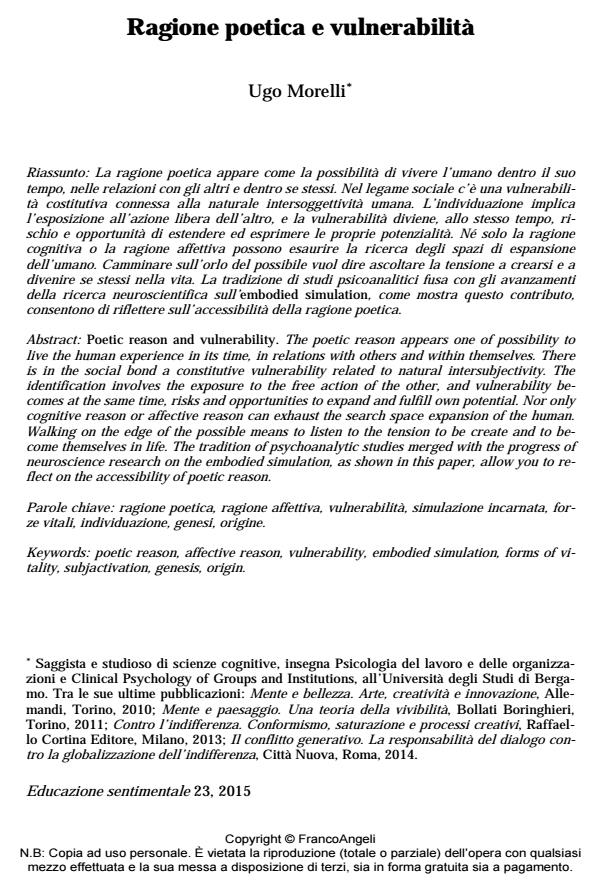Ragione poetica e vulnerabilità
Journal title EDUCAZIONE SENTIMENTALE
Author/s Ugo Morelli
Publishing Year 2015 Issue 2015/23
Language Italian Pages 13 P. 15-27 File size 85 KB
DOI 10.3280/EDS2015-023003
DOI is like a bar code for intellectual property: to have more infomation
click here
Below, you can see the article first page
If you want to buy this article in PDF format, you can do it, following the instructions to buy download credits

FrancoAngeli is member of Publishers International Linking Association, Inc (PILA), a not-for-profit association which run the CrossRef service enabling links to and from online scholarly content.
Poetic reason and vulnerability. The poetic reason appears one of possibility to live the human experience in its time, in relations with others and within themselves. There is in the social bond a constitutive vulnerability related to natural intersubjectivity. The identification involves the exposure to the free action of the other, and vulnerability becomes at the same time, risks and opportunities to expand and fulfill own potential. Nor only cognitive reason or affective reason can exhaust the search space expansion of the human. Walking on the edge of the possible means to listen to the tension to be create and to become themselves in life. The tradition of psychoanalytic studies merged with the progress of neuroscience research on the embodied simulation, as shown in this paper, allow you to reflect on the accessibility of poetic reason.
Keywords: Poetic reason, affective reason, vulnerability, embodied simulation, forms of vitality, subjactivation, genesis, origin
- Bowlby J. (1989). Attaccamento e perdita, vol. I. Torino: Bollati Boringhieri.
- Brown B. (2012). Daring Greatly: How the Courage to Be Vulnerable Transforms the Way We Live, Love, Parent, and Lead. New York City: Gotham.
- Butler J. (2004). Vite precarie. Roma: Meltemi.
- Deguy M. (2000). La raison Poétique. Paris: Galilée.
- Eliot T.S. (1970). Opere. S. Rosati, a cura di. Torino: UTET.
- Fachinelli E. (1989). La mente estatica. Milano: Adelphi, Milano.
- Foucault M. (1978). La volontà di sapere. Milano: Feltrinelli.
- Gallese V. (2014). Bodily Self e schizofrenia. Congresso FIAP, Riva del Garda, 2-5 ottobre 2014.
- Gargani A.G. (1992). Il coraggio di essere. Roma-Bari: Laterza.
- Gould S.J. (1977). Ontogeny and Philogeny. Boston Mass.: Harvard University Press. Ed. It.: Ontogenesi e filogenesi. Milano-Udine: Mimesis, 2013.
- Hillman J. (2007). Mithic Figures. Published by Arrangement with Agenzia Santachiara. Ed. it.: Figure del mito. Milano: Adelphi , 2014.
- Jauss H.R. (1982). Toward an Aesthetic of Reception. University of Minnesota Press.
- Keats J. (1817). Lettera a George e Tom Keats del 21 dicembre 1817. In: Lettere sulla poesia. Milano: Mondadori, 2005.
- Meltzer D. (1981). Sulla comprensione della bellezza. In: La comprensione della bellezza. Torino: Loescher.
- Meltzer D. (1987). Studi di metapsicologia allargata. Milano: Raffaello Cortina Editore.
- Meltzer D., Mag Harris W. (1989). Amore e timore della bellezza. Roma: Borla.
- Morelli U. (2010). Mente e bellezza. Arte, creatività e innovazione. Postfazione di Vittorio Gallese. Torino: Allemandi.
- Morelli U. (2013). Contro l’indifferenza. Conformismo, saturazione e possibilità creative. Milano: Raffaello Cortina Editore.
- Morelli U. (2014). Il conflitto generativo. La responsabilità del dialogo contro la globalizzazione dell’indifferenza. Roma: Città Nuova Editrice.
- Moro A. (2006). I confini di Babele. Milano: Longanesi.
- Moro A. (2012). Parlo dunque sono. Milano: Adelphi. Pagliarani L. (1986). Il coraggio di Venere. Milano: Raffaello Cortina Editore. Terza edizione 2009.
- Pagliarani L. (1993). Violenza e bellezza. Il conflitto negli individui e nelle istituzioni. C. Weber e U. Morelli, a cura di. Milano: Guerini e associati, 2010, terza edizione.
- Stern D. (2010). Forms of Vitality. Oxford Mass.: Oxford University Press. Ed. it.: Raffaello Cortina Editore
- White T.H. (1958). The Once and Future King. Ed. It.: Re in eterno. Milano: Mondadori.
- Winnicott D. (1958). Oggetti transazionali e fenomeni transizionali. In: Dalla pediatria alla psicoanalisi. Firenze: Martinelli, 1975.
- Zambrano M. (1950). Hacia un saber sobre el alma. Fundacion Maria Zambrano. Ed. it.: Verso un sapere dell’anima. A cura e con un’introduzione di Rosella Prezzo. Milano: Raffaello Cortina Editore, 1996
- Appadurai A. (2005). Sicuri da morire. La violenza nell'epoca della globalizzazione. Roma: Meltemi.
- Balint M. (1990). Medico, paziente, malattia. Milano: Feltrinelli, Milano.
- Benjamin W. (1925). The Origin of German Tragic Drama. Testo disponibile al sito: www.arthistoryustuffed.com.
Ugo Morelli, Ragione poetica e vulnerabilità in "EDUCAZIONE SENTIMENTALE" 23/2015, pp 15-27, DOI: 10.3280/EDS2015-023003